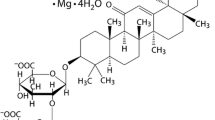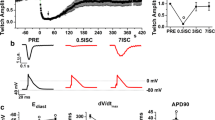Abstract
We investigated the temporal relationship between the adenosine triphosphate-sensitive K current (Katp current), hypoxic shortening and Ca accumulation in cardiomyocytes exposed to anoxia or metabolic inhibition. Whole-cell, patch-clamp experiments were performed with nonstimulated isolated rat heart ventricular muscle cells loaded with the Ca-sensitive fluorescent dye l-[2-(5-carboxyoxazol-2-yl)-6-amino-benzofuran-5-oxy]-2-(2′-amino-5′-methylphenoxy) ethane-N,N,N′,N′-tetraacetic acid (fura-2) via the patch pipette. After approximately 8 min anoxia, the K ATP current started to rise and reached a maximum of 21.3 ± 3.7 nA (n = 5, recorded at 0 mV clamp potential) within 1–3 min. At that time hypoxic contracture also occurred. Resting cytoplasmic free calcium (Cai) did not change significantly before hypoxic shortening. After hypoxic contracture, the KATP current decreased and Cai started to rise, reaching about 1 μmol/l. The presence of glibenclamide (10μmol/l) in the bath reduced the anoxia-induced KATP current by more than 50%, but did not significantly influence the time dependence of current, hypoxic shortening and Cai, or the magnitude of Cai. Metabolic inhibition with 1.5 mmol/1 CN resulted in KATP current increase and hypoxic shortening, occurring somewhat earlier than under anoxia, but all other parameters were comparable. In non-patch-clamped cells loaded with fura-2 AM ester and field-stimulated with 1 Hz, 1 μmol/1 glibenclamide had no significant effect on the magnitude of the Cai increase caused by exposure of the cells to 1.5 mmol/1 CN-. After CN- wash-out in non-patch-clamped cells, Cai declined, oscillated and finally returned to control values. It can be concluded that glibenclamide inhibits anoxia-induced KATP currents only partially and has no significant effect on anoxiainduced rise in resting Cai.
Similar content being viewed by others
References
Allshire A, Piper HM, Cuthbertson KSR, Cobbold PH (1987) Cytosolic free Ca2+ in single rat heart cells during anoxia and reoxygenation. Biochem J 244:381–385
Behling RW, Malone HJ (1995) ATATP-channel openers protect against increased cytosolic calcium during ischaemia and reper- fusion. J Mol Cell Cardiol 27:1809–1817
Benndorf K, Bollmann G, Friedrich M, Hirche H (1992) Anoxia induces time-independent K+ current through KATP channels in isolated heart cells of the guinea-pig. J Physiol (Lond) 454:339–357
Bowers KC, Allshire AP, Cobbold PH (1992) Bioluminesent measurement in single cardiomyocytes of sudden cytosolic ATP depletion coincident with rigor. J Mol Cell Cardiol 24:213–218
Deutsch N, Weiss JN (1994) Effects of trypsin on cardiac ATP- sensitive Kn+ channels. Am J Physiol 266:H613-H622
Findlay I (1993) Sulphonylurea drugs no longer inhibit ATP- sensitive Kn+ channels during metabolic stress in cardiac muscle. J Pharmacol Exp Ther 266:456–467
Fralix TA, Steenbergen C, London RE, Murphy E (1993) Glibenclamide does not abolish the protective effect of preconditioning on stunning in the isolated perfused rat heart. Cardiovasc Res 27:630–637
Goldhaber JI, Parker JM, Weiss JN (1991) Mechanisms of excitation-contraction coupling failure during metabolic inhibition in guinea-pig ventricular myocytes. J Physiol (Lond) 443:371–386
Gross GJ, Auchampach JA (1992) Blockade of ATP-sensitive potassium channels prevents myocardial preconditioning in dogs. Circ Res 70:223–233
Grynkiewicz G, Poenie M, Tsien RY (1985) A new generation of Ca2+ indicators with greatly improved fluorescence properties. J Biol Chem 260:3440–3450
Haigney MCP, Miyata H, Lakatta EG, Stern MD, Silverman HS (1992) Dependence of hypoxic cellular calcium loading on Na+-Ca2+ exchange. Circ Res 71:547–557
Hamill OP, Marty A, Neher E, Sakmann B, Sigworth FJ (1981) Improved patch-clamp techniques for high-resolution current recording from cells and cell-free membrane patches. Pflügers Arch 391:85–100
Hearse DJ (1995) Activation of ATP-sensitive potassium channels: novel pharmacological approach to myocardial protection? Cardiovasc Res 30:1–17
Katnik C, Adams DJ (1995) An ATP-sensitive potassium conductance in rabbit arterial endothelial cells. J Physiol (Lond) 485:595–606
Krause E, Englert H, Gögelein H (1995) Adenosine triphos- phate-dependent K currents activated by metabolic inhibition in rat ventricular myocytes differ from those elicited by the channel opener rilmakalim. Pflügers Arch 429:625–635
Krüger C, Erdmann E, Näbauer M, Beuckelmann DJ (1994) Intracellular calcium handling in isolated ventricular myocytes from cardiomyopathic hamsters (strain BIOL 14.6) with congestive heart failure. Cell Calcium 16:500–508
Nichols CG, Lopatin AN (1993) Trypsin and α-chymotrypsin treatment abolishes glibenclamide sensitivity of KATP channels in rat ventricular myocytes. Pflügers Arch 422:617–619
Noma A (1983) ATP-regulated K+ channels in cardiac muscle. Nature 305:147–148
Schulz R, Rose J, Heusch G (1994) Involvement of activation of ATP-dependent potassium channels in ischaemic preconditioning in swine. Am J Physiol 267:H1341-H1352
Siegmund B, Ladilov YV, Piper HM (1994) Importance of sodium for recovery of calcium control in reoxygenated cardiomyocytes. Am J Physiol 267:H506-H513
Stern MD, Silverman HS, Houser SR, Josephson RA, Capogrossi MC, Nichols CG, Lederer WJ, Lakatta EG (1988) Anoxic contractile failure in rat heart myocytes is caused by failure of intracellular calcium release due to alteration of the action potential. Proc Natl Acad Sci U S A 85:6954–6958
Thierfelder S, Doepner B, Gebhardt C, Hirche H, Benndorf K (1994) ATP-sensitive K+ channels in heart muscle cells first open and subsequently close at maintained anoxia. FEBS Lett 351:365–369
Venkatesh N, Lamp ST, Weiss, JN (1991) Sulphonylureas, ATP-sensitive K+ channels, and cellular K+ loss during hypoxia, ischemia, and metabolic inhibition in mammalian ventricle. Circ Res 69:623–637
Walsh RS, Tsuchida A, Daly JJF, Thornton JD, Cohen MV, Downey JM (1994) Ketamine-xylazine anaesthesia permits a KATP channel antagonist to attenuate preconditioning in rabbit myocardium. Cardiovasc Res 28:1337–1341
Weiss JN, Lamp ST (1989) Cardiac ATP-sensitive K+ channels: evidence for preferential regulation by glycolysis. J Gen Physiol 94:911–935
Yazawa K, Kaibara M, Ohara M, Kameyama M (1990) An improved method for isolating cardiac myocytes useful for patch-clamp studies. Jpn J Physiol 40:157–163
Author information
Authors and Affiliations
Rights and permissions
About this article
Cite this article
Ruß, U., Englert, H., Schölkens, B.A. et al. Simultaneous recording of ATP-sensitive K+ current and intracellular Ca2+ in anoxic rat ventricular myocytes. Effects of glibenclamide. Pflügers Arch — Eur J Physiol 432, 75–80 (1996). https://doi.org/10.1007/s004240050107
Received:
Revised:
Accepted:
Issue Date:
DOI: https://doi.org/10.1007/s004240050107




